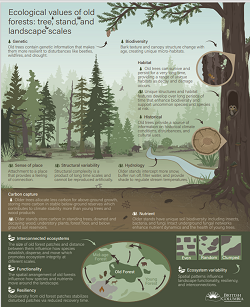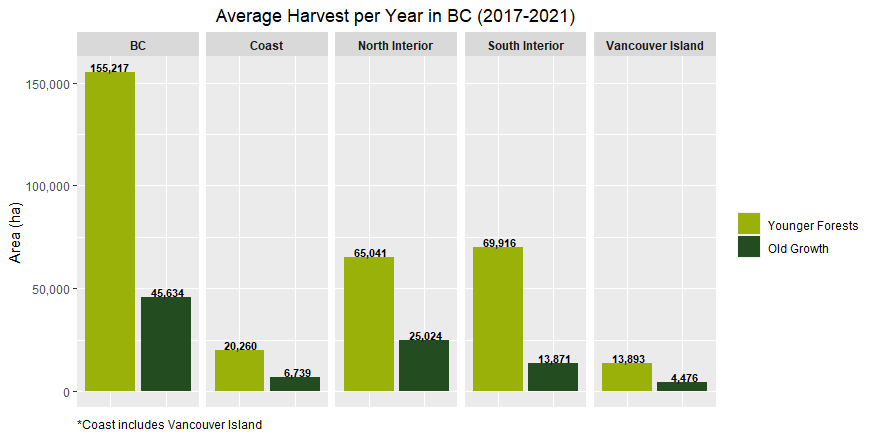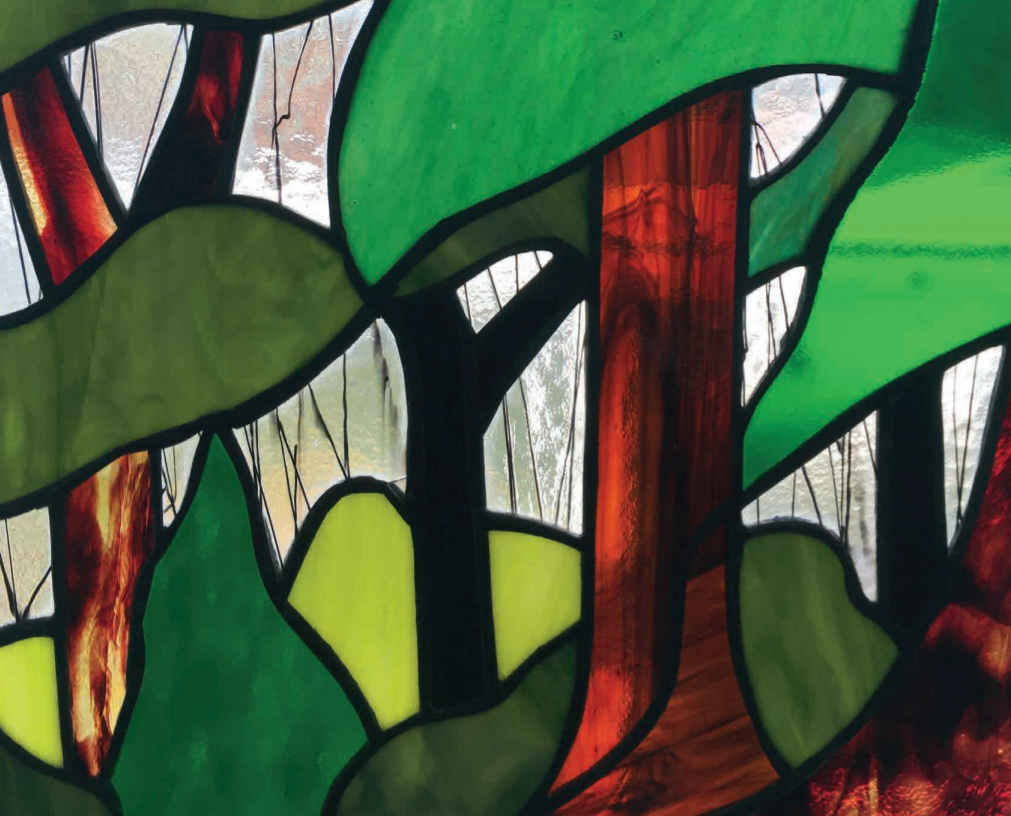Old growth definitions and values

Currently, old growth definitions in B.C. are based on age, typically 250 years for the wet coastal and interior wet belt regions. Dry interior forests are usually considered old at 140 years as there are more frequent disturbances such as fire and insect infestations.
On this page:
- Old growth characteristics
- The importance of conserving old forests
- Ecological values
- Social and cultural values
- Employment and economic values
Old growth characteristics
New definitions for old growth are being considered that include stand structure attributes and ecological processes, rather than just age.
Characteristics of old growth forests vary according to location and tree species. However, it is commonly agreed that they tend to have more standing dead trees, or snags, and decomposing wood than younger forests. The trees are often larger, and the forest canopy is layered, with openings that allow light, encouraging the growth of understory vegetation such as ferns, shrubs, mosses and lichens.
Conserving old growth forests
There are many reasons for conserving old growth forests including:
- Old forests provide unique habitats, structures, and ecological functions not available in younger stands.
- Old forests are very important to First Nations and the public, whether for biological, spiritual, aesthetic, economic or cultural values.
- Old forests are not easily replaced; it takes at least 2-3 human lifespans (140-250 years) to grow back an old growth forest and another 2-3 times as long for an ancient forest to develop.
Ecological values
The ecological values of old growth forests can be described at the tree, stand and landscape levels.
Old growth ecosystems support diverse flora and fauna, from mosses and liverworts to large mammals and species at risk. These forests also provide habitat for many birds, mammals, and amphibians.
Government has protected old growth forests in areas throughout the province to support species that depend on them. These include:
- Marbled murrelet
- Northern goshawk
- Fisher
- Marten
- Pileated woodpecker
- Caribou
Forests play a significant role in reducing greenhouse gas emissions, and in the rate and impacts of climate change. Forests remove carbon from the atmosphere and store that carbon as above-ground and below-ground organic matter (living and dead).
Social and cultural values
Old growth forests and iconic trees are valued by many British Columbians and visitors for their social and cultural significance, particularly on the West Coast. B.C.’s diverse old growth forests are symbolic of the province’s natural heritage. Old growth forests attract visitors from around the world and are enjoyed for their outdoor recreation opportunities.
Indigenous Peoples of B.C. have a long-standing cultural and spiritual connection to the province’s forests, including old growth. Old growth forests are also important to Indigenous practices that have been passed down for generations (e.g., the practice of altering or modifying trees). The Heritage Conservation Act protects these culturally modified trees, altered by Indigenous Peoples before 1846, as part of their traditional use of forests.
The Province is committed to true, lasting reconciliation with Indigenous Peoples through the implementation of the UN Declaration. This work will foster increased and lasting certainty on the land base while ensuring that the benefits of sustainable forest harvesting are realized equitably by those engaged in and impacted by the forestry industry.
To learn more about how the province is working with B.C. First Nations to protect Indigenous values through management of the land base, refer to:
Employment and economic values
The forest sector has always been a cornerstone of British Columbia’s economy. In 2022, the forest sector was responsible for $15.6 billion of B.C.’s total exports and it is the primary employer in several parts of the province. Forestry-related activities directly support over 6,570 businesses and employ roughly 56,100 people. Forest products represent 24% of B.C.’s commodity exports. Roughly 74% of B.C.’s manufactured forest product value is sold to international markets.
In fiscal year 2021/22, the B.C. government reported that $1.9 billion in government revenue was attributable to the forest sector, primarily from timber sales. Forest sector companies and their employees also pay income tax and commodity taxes, generating more revenue on top of the $1.9 billion. This revenue funds infrastructure and government services that British Columbians depend on.
Harvesting
Old growth is harvested on B.C.’s coast, on Vancouver Island and in both the northern and southern interior. Trees are logged by large and small independent companies, by community forest associations, by Indigenous Nations, and by other communities and individuals with woodlot licences.
Wood from old growth trees is often desired for high-end and specialty products such as fine furniture, musical instruments, specialty finishing products and shake and shingle manufacturing. Old growth trees are also used to make lumber, with wood waste from harvesting and milling used by the pulp and paper sector. Old growth cedar trees are particularly valuable to certain sectors of the forest industry.
There are about 11.1 million hectares of old growth forest in B.C. which make up about 20% of B.C.’s publicly managed forest areas. Most of the old growth in B.C. - around 9 million hectares – is protected or not economical to harvest.
Timber Harvesting Land Base
The Timber Harvesting Land Base is approximately 22.3 million hectares, of which about 3 million hectares is old-growth forest. To put this in perspective, British Columbia is roughly 95 million hectares in size. Approximately 56.2 million hectares of British Columbia is publicly managed forest.
On average, around 200,000 hectares of forested lands are harvested every year in B.C. (based on 2017-2021 data). This is about 1% of the overall timber harvesting land base. About 22% of the annual harvest comes from old growth. The majority is from non-old growth stands.
Regional harvest levels are illustrated in the table below:



